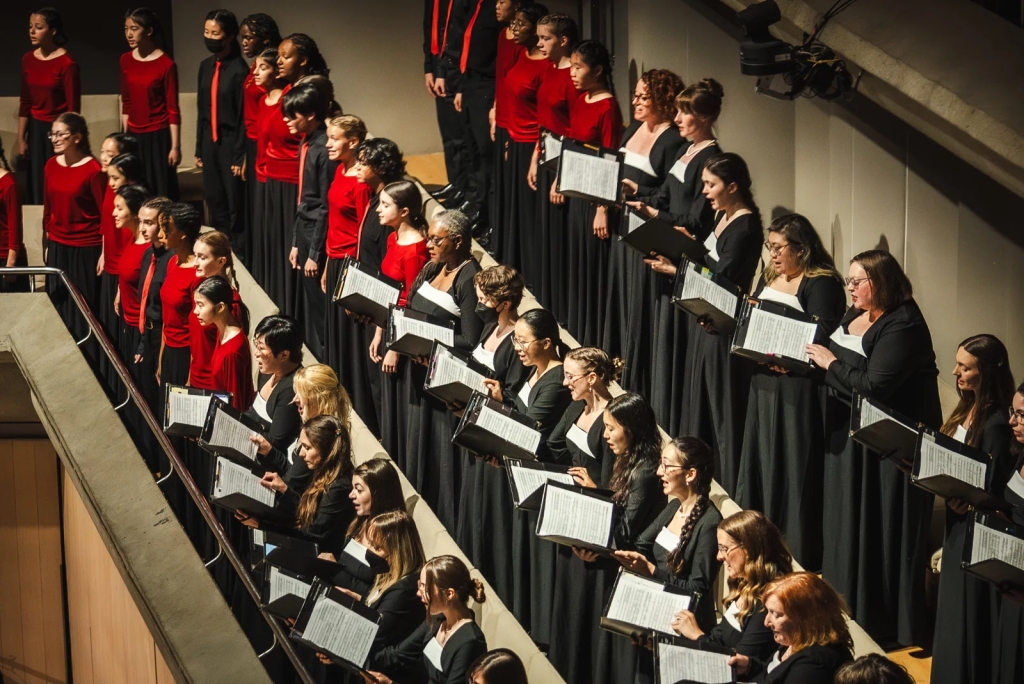If that headline sounds like a mouthful you should hear Mahler’s 3rd Symphony. I just did tonight at Roy Thomson Hall.
The Toronto Symphony led by music director Gustavo Gimeno aided by members of the Mendelssohn Choir, the Toronto Children’s Chorus and alto Gerhild Romberger gave us this most ambitious composition, Mahler’s longest work at over 90 minutes in length. Whether celebrating the arrival of the god Pan, listening to nature in a forest or the angels singing of salvation, Mahler takes us on a cathartic journey from darkness to light.
It’s a very theatrical piece, sometimes requiring musicians to play from offstage, an effect that I always find magical even if I didn’t already know about Mahler’s spirituality.
I’ve heard several performances of Mahler’s 2nd symphony (titled “the Resurrection”) recently, already a massive undertaking. The 3rd Symphony is bigger, which might explain why it’s not undertaken as often. In his previous symphony we hear musicians offstage as though marching somewhere in the afterlife. Similarly this time we hear a posthorn playing from the back, and drums from outside somewhere. And that’s just the invisible voices.
No wonder when you consider the elaborate program Mahler gave the work in his correspondence, giving the six movements titles:
1: Introduction: Pan Awakes, Summer Marches in
2: What the flowers in the meadow Tell Me
3: What the Animals in the Woods Tell Me
4: What Mankind Tells Me
5: What the Angels Tell Me
6: What Love Tells Me
At first glance you might wonder: is he for real? Now imagine that a composer could actually write music to live up to such titles. The themes and sentiments being expressed are larger than life so no wonder the orchestra and its sounds must also be massive for such powerful ideas, although they are often contrasted with the most delicate melodies inserted between the climaxes, played as solos or by small groups of instruments. I’m very impressed with the way Gimeno restrains the TSO forces, often playing for long stretches in the softest most delicate sound, gradually building to climaxes to knock your socks off.
The first movement is roughly a half hour of drama, going from darkness to light, back and forth several times. The brass are especially challenged by a piece that is beyond all but the very finest orchestral players. The members of your 2024 Toronto Symphony have been carefully recruited to build a virtuoso ensemble capable of playing just about anything. That opening movement reminds me of the good old days of stereo buying, when one would take records into the shop with the intention of testing the sound coming from the devices, only this time we were testing Roy Thomson Hall with the phenomenal output of this elite band playing such powerful music.
The second movement is a superb contrast, beginning with a sweet minuet, at least on the surface. Soon Mahler subverts his own delicacy with quick quirky phrases from the woodwinds and strings, like 20th century modernism imminently breaking through the safer surface of the past. Gimeno always keeps it under control, wonderfully transparent in texture.
I find myself hypnotized by the sounds of that third movement, even if I don’t connect it in any way to that title I quoted above. Is it really “What the Animals in the Woods Tell Me”? I don’t believe titles matter that much except as a poetic departure point. I read this one much more in spiritual terms, especially the poignant sound of the posthorn drifting through the walls from the back. It’s one of several delightful melodies sprinkled among quicker passages, shifting moods.
We begin the fourth movement with a deep alto intoning lines from Nietzsche’s Zarathustra questioning us. Romberger’s voice is as rich and dark a sound as any you will ever hear, to confront you with the simplest but most profound enquiry about the meaning of your life. We hear questions rather than answers.
Moments later the combined forces of the Toronto Children’s Chorus and some members from the Toronto Mendelssohn Choir take us in a very different direction, the voices of angels bursting with light in contrast to the darkness of the alto’s voice, and as a kind of reply to the alto questioning. This is but one of several moments to make me smile. And I was moved to tears, not for the first time.
The last movement is again an opportunity to discover the subtleties of Mahler, courtesy of Gimeno and his soft touch with the TSO. I have heard some interpretations that get louder sooner, a challenge both to the players and the listeners. Gimeno clearly knows his team, holding them back thoughtfully so that when we come to the climactic phrases they have plenty left. And it means our experience builds slowly to a magnificent climax.
The concert will be repeated Thursday and Saturday June 13 and 15.




